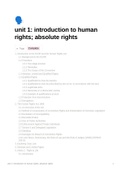Class notes
PGDL University of Law Administrative Law & Human Rights Distinction Notes 2023/2024
- Course
- Institution
A collection of notes for the Administrative Law & Human Rights module on the PGDL course at University of Law. I took the online course in 2023/2024, and achieved a 77% using these notes.
[Show more]



